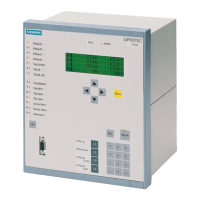Interaction with the Automatic Reclosure Function
Automatic reclosure is not an effective measure against intermittent ground faults as the function only trips
after repeated detection of a fault or after expiration of the summation monitoring time T-sum det. and
besides this, its basic design is to prevent thermal overload. For these reasons, the intermittent ground fault
protection is not implemented as starting feature of the automatic reclosing function.
Interaction with Breaker Failure Protection
A pickup that is present when the time delay TRIP-Timer has expired is interpreted by the breaker failure
protection as a criterion for a tripping failure. Since permanent pickup is not ensured after a tripping command
by the intermittent ground fault protection, cooperation with the breaker failure protection is not sensible.
Therefore, this function is not activated by the intermittent ground fault protection.
Logic Diagram
The following figure shows the logic diagram for the intermittent ground fault protection function.
[7sj6x_intermit_erdfehler-150502-kn, 1, en_US]
Figure 2-98
Logic diagram of the intermittent ground fault protection – principle
Fault Logging
A fault event and thus fault logging is initiated when the non-stabilized ΙΙE element picks up for the first time.
A message
IIE Fault det
is produced. The message
IIE Fault det
is issued and entered in the fault
log (and reported to the system interface) so often until the number of pickups
IIE Fault det
has reached
the value set for parameter Nos.det.. When this happens, the message
Intermitt.EF
is issued and
IIE
Functions
2.14 Intermittent Ground Fault Protection
226 SIPROTEC 4, 7SJ62/64, Manual
C53000-G1140-C207-8, Edition 08.2016

